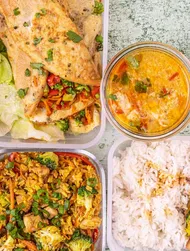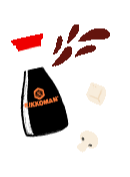Our puff pastry recipes are versatile in every way!
17. October 2024

Filo, filo pastry, yufka – puff pastry goes by many names
Historians trace the culinary origins of puff pastry back to the Egyptian Mediterranean region. It made its way to France via the south, where this airy, buttery delicacy became a staple in fine pastries. But puff pastry is also unbeatably good in more savoury dishes. We know it as yufka in Turkish cuisine for börek and similar dishes. The British, who also have a sweet tooth, conjure up the most amazing dishes with it and call it "puff pastry" because the dough puffs up so beautifully when baked.
Light and fluffy without yeast – how to make puff pastry
Before you get to savour the treat, a little effort in the kitchen is required. Puff pastry is made from the basic ingredients of wheat flour, salt and water. After kneading, the real work begins: rolling out the dough and layering it with cold butter or oil. The dough is then folded and rolled out repeatedly, a process known as "touring". The more tours you do, the flakier the dough is when baked. In the end, good puff pastry consists of about 140 layers! Thanks to all the love and care that goes into the dough, no yeast is needed at all.
Quick and easy from the supermarket fridge
Since homemade puff pastry requires so much time and effort, it's perfectly acceptable to use ready-made products. You can choose between fresh or frozen pastry. Both work equally well if you follow a few simple rules. One of these is to temper the dough properly. It should be taken out of the fridge in good time and ideally be at room temperature. Frozen pastry should also be allowed to thaw slowly and completely before working with it. Only then will it bake up really light and airy!
Don't knead it!
To ensure puff pastry rises properly, avoid kneading it. If you need larger pieces, you can overlap individual sheets as closely as possible at the edges and press them together gently. And always use a sharp knife to create clean edges when shaping the dough.
Hot oven, best results
There are also a few pro tips for baking to ensure perfect results. The oven has to be hot! Between 200 ˚C and 220 ˚C is best. Preheating is a must! Top and bottom heat or fan are equally good; just go with what the recipe recommends. And whatever you do, don't prick the pastry with a fork if you want it to rise - it doesn't like that at all. Before baking, you can brush it with egg, milk, sugar or butter. If you're cooking or baking with vegan puff pastry, you can also use water or plant milk to coat it.
Delicious puff pastry ideas
Are you already in the mood for this light and airy culinary delight? Here are some creative ideas for what you can conjure up with this delicious pastry. But of course, the only limit is your imagination!
Sweet tarts & pies
- Tarte with salted caramel
- Tarte Tatin or lemon tart (without shortcrust pastry for a change)
- Chocolate tart
- Apple pie
- Pumpkin pie
Savoury quiches & pies
- Quiche Lorraine
- Vegetable quiche
- Salmon quiche
- Onion tart
- Chestnut and mushroom pie
Strudels
- French lentil strudel
- Sweet apple strudel
Wellington-style
- Classic beef Wellington
- Mushroom Wellington
- Fish Wellington
Finger food
- Samosas
- Pizza rolls
- Party sticks
- Pigs in blankets


![[Translate to Englisch (UK):] [Translate to Englisch (UK):]](https://www.kikkoman.co.uk/fileadmin/_processed_/6/6/csm_UK139_recipe_page_best_steak_pie_recipe_Desktop_56f545ee7a.webp)







![[Translate to Englisch (UK):] [Translate to Englisch (UK):]](https://www.kikkoman.co.uk/fileadmin/_processed_/9/4/csm_Blogpage_How_To_Master_Velveting_Desktop-Header_f36d5cca18.webp)

![[Translate to Englisch (UK):] [Translate to Englisch (UK):]](https://www.kikkoman.co.uk/fileadmin/_processed_/c/d/csm_1039-recipe-page-Easy-Carrot-soup_mobile_7366116d92.webp)
![[Translate to Englisch (UK):] [Translate to Englisch (UK):]](https://www.kikkoman.co.uk/fileadmin/_processed_/1/0/csm_1089-recipe-page-Roasted-Turkey_mobile_624c3fe100.webp)
![[Translate to Englisch (UK):] [Translate to Englisch (UK):]](https://www.kikkoman.co.uk/fileadmin/_processed_/c/5/csm_MainDishes_recipe-collection_desktop_2x_ef5962097e.webp)
![[Translate to Englisch (UK):] [Translate to Englisch (UK):]](https://www.kikkoman.co.uk/fileadmin/_processed_/b/e/csm_1101-recipe-page-Authentic-Japanese-soy-sauce-ramen_mobile_6bf05afcae.webp)
![[Translate to Englisch (UK):] [Translate to Englisch (UK):]](https://www.kikkoman.co.uk/fileadmin/_processed_/e/b/csm_918-recipe-page-pumpkin-hummus_mobile_d372eb934b.webp)

![[Translate to Englisch (UK):] [Translate to Englisch (UK):]](https://www.kikkoman.co.uk/fileadmin/_processed_/0/d/csm_928-recipe-page-prawn-and-vegetable-stir-fry-noodles_mobile_78dc5b25bc.webp)




